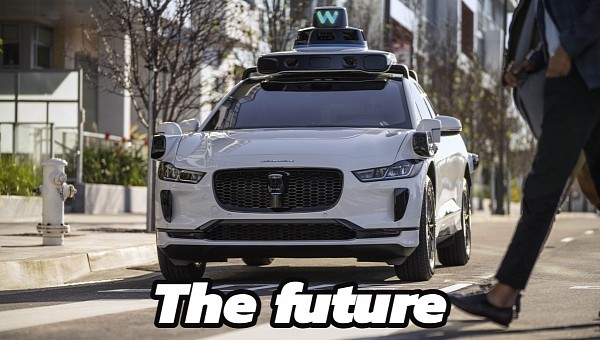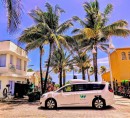Waymo will become an all-electric company, as it plans to retire its Chrysler Pacifica minivan fleet and switch to using Jaguar I-Pace SUVs instead. The Jaguar I-Pace is a stopgap solution until its partner, Geely, is ready with an autonomous vehicle under the ZEEKR brand.
Next to GM's Cruise, Waymo is among the most advanced robotaxy company and one of the few allowed to operate a commercial service. The Alphabet subsidiary launched in 2009 as the Google Self-Driving Car Project and was rebranded in 2016 as Waymo, following the corporate restructuring that left us with the bland Alphabet name. Since it started operation, Waymo has retrofitted various types of vehicles with autonomous-driving tech, including Lexus RX450h, Toyota Prius, and Chrysler Pacifica.
The plug-in hybrid minivans supplied by Stellantis were the backbone of the Waymo fleet. In 2018, Alphabet announced plans to add 62,000 Pacifica hybrids to the fleet, although that didn't happen. Waymo ordered 20,000 Jaguar I-Pace electric SUVs the same year, even before Jaguar Land Rover presented the first prototype. As the world changes and the interest in electric vehicles increases, Waymo will retire its Chrysler Pacifica fleet to become an all-electric robotaxi company. It's hard to admit, but GM was more forward-thinking in this regard, considering that all Cruise robotaxis are electric Chevy Bolt.
The Jaguar I-Pace that will replace the Pacifica minivans comes loaded with the fifth-generation Waymo Driver technology. Along with the Pacifica, Waymo also retires the fourth generation of its autonomous-driving software from the service. The move makes the entire Waymo One ride-hailing fleet fully electric. Waymo says this is meant to support the White House's efforts to transition to electric vehicles if you're wondering why.
Like all electric vehicles, Waymo's I-Pace robotaxis generate fewer carbon emissions. The savings are multiplied because Waymo AVs are not supposed to spend time off the road. The more they drive, the easier it is to see the environmental benefits. Waymo also promises to use 100% renewable energy to charge cars, enabling a zero-emissions service to customers. The new electric robotaxis will be deployed in Chandler, Mesa, and Tempe, Arizona, an area where Waymo started operating commercial services in 2019.
Waymo partnered with Geely in 2021 to develop its next-generation autonomous driving vehicles under the ZEEKR brand. According to previous communication, these vehicles would be optimized for transportation as a service (TaaS). They feature a flat floor, a pillar-less design, generous headroom, and legroom, as well as adjustable seats. Similar to Cruise Origin pods, Waymo's ZEEKR AVs will feature no steering will or pedals, although they have a more traditional minivan shape.
Waymo might be further ahead than other AV startups, but it wasn't spared the controversies. The Alphabet subsidiary leads Cruise in the number of traffic incidents. Recently, a Waymo I-Pace was caught on camera making a controversial maneuver in San Francisco. This proves that autonomous vehicles are still a pipe dream, no matter what automotive platform they use.
The plug-in hybrid minivans supplied by Stellantis were the backbone of the Waymo fleet. In 2018, Alphabet announced plans to add 62,000 Pacifica hybrids to the fleet, although that didn't happen. Waymo ordered 20,000 Jaguar I-Pace electric SUVs the same year, even before Jaguar Land Rover presented the first prototype. As the world changes and the interest in electric vehicles increases, Waymo will retire its Chrysler Pacifica fleet to become an all-electric robotaxi company. It's hard to admit, but GM was more forward-thinking in this regard, considering that all Cruise robotaxis are electric Chevy Bolt.
The Jaguar I-Pace that will replace the Pacifica minivans comes loaded with the fifth-generation Waymo Driver technology. Along with the Pacifica, Waymo also retires the fourth generation of its autonomous-driving software from the service. The move makes the entire Waymo One ride-hailing fleet fully electric. Waymo says this is meant to support the White House's efforts to transition to electric vehicles if you're wondering why.
Like all electric vehicles, Waymo's I-Pace robotaxis generate fewer carbon emissions. The savings are multiplied because Waymo AVs are not supposed to spend time off the road. The more they drive, the easier it is to see the environmental benefits. Waymo also promises to use 100% renewable energy to charge cars, enabling a zero-emissions service to customers. The new electric robotaxis will be deployed in Chandler, Mesa, and Tempe, Arizona, an area where Waymo started operating commercial services in 2019.
Waymo partnered with Geely in 2021 to develop its next-generation autonomous driving vehicles under the ZEEKR brand. According to previous communication, these vehicles would be optimized for transportation as a service (TaaS). They feature a flat floor, a pillar-less design, generous headroom, and legroom, as well as adjustable seats. Similar to Cruise Origin pods, Waymo's ZEEKR AVs will feature no steering will or pedals, although they have a more traditional minivan shape.
Waymo might be further ahead than other AV startups, but it wasn't spared the controversies. The Alphabet subsidiary leads Cruise in the number of traffic incidents. Recently, a Waymo I-Pace was caught on camera making a controversial maneuver in San Francisco. This proves that autonomous vehicles are still a pipe dream, no matter what automotive platform they use.






